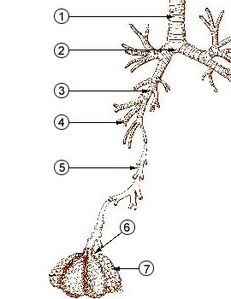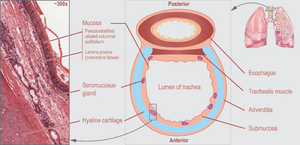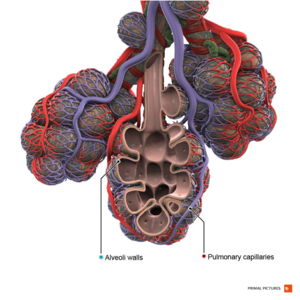Tracheobronchial Tree: Difference between revisions
mNo edit summary |
mNo edit summary |
||
| Line 13: | Line 13: | ||
* It is a system that participate to gas exchage.<ref>[https://www.ncbi.nlm.nih.gov/books/NBK556044/ Downey] RP, Samra NS. [https://www.ncbi.nlm.nih.gov/books/NBK556044/ Anatomy, Thorax, Tracheobronchial Tree]. InStatPearls [Internet] 2020 Jul 31. StatPearls Publishing.</ref> | * It is a system that participate to gas exchage.<ref>[https://www.ncbi.nlm.nih.gov/books/NBK556044/ Downey] RP, Samra NS. [https://www.ncbi.nlm.nih.gov/books/NBK556044/ Anatomy, Thorax, Tracheobronchial Tree]. InStatPearls [Internet] 2020 Jul 31. StatPearls Publishing.</ref> | ||
There are approximately 23 generations | There are approximately 23 generations of airway in the human lung extending from trachea (generation 0) to the last order of terminal bronchioles (generation 23). | ||
{| class="wikitable" | {| class="wikitable" | ||
|+ | |+ | ||
| Line 19: | Line 19: | ||
! | ! | ||
|- | |- | ||
|''Conducting | |''Conducting zones'' | ||
| | | | ||
|- | |- | ||
| Line 38: | Line 38: | ||
|- | |- | ||
|16 | |16 | ||
|<small>Terminal bronchioles</small> | |||
|- | |||
|''Respiratory zones'' | |||
| | | | ||
|- | |||
|17- 19 | |||
|<small>Respiratory bronchioles</small> | |||
|- | |||
|20-23 | |||
|<small>Alveolar ducts , alveoli</small> | |||
|} | |} | ||
* 0 generation - Trachea | * 0 generation - Trachea | ||
Revision as of 16:22, 22 April 2022
Original Editor - User Name
Top Contributors - Stella Constantinides and Kim Jackson
Introduction[edit | edit source]
The tracheobronchial tree is a branching tree of airways composed of:
- the trachea
- the bronchi
- the bronchioles.
- It is a system that participate to gas exchage.[1]
There are approximately 23 generations of airway in the human lung extending from trachea (generation 0) to the last order of terminal bronchioles (generation 23).
| Generations | |
|---|---|
| Conducting zones | |
| 0 | Trachea |
| 1 | Primary bronchus |
| 2 | Lobar bronchus |
| 3 | Segmental bronchus |
| 4, 5, 6 | Subsegmental bronchus |
| 16 | Terminal bronchioles |
| Respiratory zones | |
| 17- 19 | Respiratory bronchioles |
| 20-23 | Alveolar ducts , alveoli |
- 0 generation - Trachea
- 1 generation - Primary bronchi
- 2 generation - Lobar brochi.
- 3 generation - Segmental bronchi
- 4 generations - Subsegmental bronchus
- 16 generation - Terminal bronchioles
- 17-19 generation - Respiratory bronchioles
- 20-22 generation - Alveolar ducts
- 16 - 23 generations - The acinus is comprised of respiratory airways and forms functional tissues (gas exchange units) of lung. The alveolar ducts are small tubes supported by a rich matrix of elastic and collagen fibres. The distal ends of alveolar ducts open into the alveolar sac which is made up by alveoli.[2][3]
Trachea[edit | edit source]
The main functions of the trachea comprise air flow into the lungs, mucociliary clearance.
The trachea is a C-shaped structure, flexible tube that is composed of hyaline cartilage on the anterior and lateral walls. Also contains of the trachealis smooth muscle forming the posterior wall of the trachea .Also the trachea is composed of several primary structural annular ligament.https://www.sciencedirect.com/topics/medicine-and-dentistry/trachealis-muscle , https://www.ncbi.nlm.nih.gov/books/NBK448070/. Posterior surface of the trachea is flat where its cartilaginous rings are incomplete (anatomy book ).
- The trachea descends from the larynx into the lung.https://www.ncbi.nlm.nih.gov/books/NBK556044/#:~:text=The%20tracheobronchial%20tree%20is%20composed,the%20lungs%20for%20gas%20exchange.
- The trachea is tube 10-12 cm.
- Is situated anterior to the oesophagus. (biblio)
- .Extends from cricoid cartilage (c6 level) by cricothyroid membrane to carina (level of sternal angle ). At the level of carina the trachea bifurcates into the right and left main bronchi.https://www.ncbi.nlm.nih.gov/books/NBK556044/#:~:text=The%20tracheobronchial%20tree%20is%20composed,the%20lungs%20for%20gas%20exchange.https://www.ncbi.nlm.nih.gov/books/NBK448070/
Inner mucosal layer made of ciliated pseudostratified columnar epithelium with goblet cells. Goblet cells produce mucus that traps airborne particles and microorganisms, and the cilia propel the mucus upward, where it is either swallowed or expelled.
Hyaline cartilage[edit | edit source]
- Series of 16 to 20 hyaline cartilage rings one top the other each is individually connected by an annular ligament.
- The tracheal cartilaginous rings, are responsible for keeping the trachea lumen open in spite of the changes in intrathoracic pressure that occur during respiration, and hence prevent air flow limitation.
Trachealis muscle[edit | edit source]
- Type of muscle = Smooth muscle
- Connects the ends of the C-shaped tracheal cartilages.
- Is in contact with the anterior esophagusThe trachealis muscle functions to constrict the airway by pulling the cartilages together, decrease the diameter , allowing for increased expiratory force during coughing with the smaller aperture allowing greater velocity to be achieved and the particle to be expelled. http://education.med.nyu.edu/Histology/courseware/modules/respiratory-sy/respiratory.07.html. This action is helpful, especially when eating food, which requires the expansion of the esophagus.
Bronchi[edit | edit source]
At the level of the fifth thoracic vertebra, the trachea divides into the left and right main bronchi. The right main bronchus has a length of 2.5 cm, and the left main bronchus is 5 cm long. https://www.sciencedirect.com/topics/medicine-and-dentistry/trachealis-
The trachea divides at the carina (at the level of the sternal angle) to give rise to the two primary bronchi – the right and left bronchus (figure X). Differences between right and left bronchus are illustrated below in table X .The right and left bronchus conduct air from the trachea into the right and left lung respectively.
The primary bronchi then branch into secondary bronchi (lobar bronchi) – three on the right and two on the left. Each secondary bronchus supplies a lobe of the lung.
Each secondary bronchi (lobar bronchi) subsequently divide into narrower tertiary bronchi (segmental bronchi) that supply bronchopulmonary segments (largest subdivisions of a lobe).
Segmental bronchi undergo further branching to form numerous smaller airways, called the bronchioles, .
| Right Bronchus | Left Bronchus |
| - Wider
- More vertical - Shorter (2-3cm) - Supported by C shaped cartilages - 20 to 30 degree angle |
- Narrower
- More angular - Longer (5cm) - Supported by C shaped cartilages - 40 to 60 degree angle |
Bronchioles[edit | edit source]
Bronchioles arise from segmental bronchi and represent the smaller branches of the bronchial tree.
Bronchioles differ histologically from bronchi as they lack C shaped cartilages in their walls. ????
Bronchioles initially divide into many generations of conducting bronchioles that eventually divide further into terminal bronchioles which further divide into respiratory bronchioles.
- Conducting bronchioles : segmental bronchi give rise to 20 to 25 generations of conducting bronchioles that further divide to terminal bronchioles.
- Terminal bronchioles : represent the last part of the conducting part of the bronchial tree and give rise to several generations of respiratory bronchiole.
- Respiratory bronchioles: distinguishable to other types of bronchioles by the presence thin walled outpocketing (alveoli) extending from their lumens. Therefore, represent the first part of the respiratory airways where they facilitate gas exchange.
This exchange occurs in the respiratory bronchioles, alveolar ducts and alveoli, which collectively form the respiratory zones deep in the lungs.
Resources
- bulleted list
- x
or
- numbered list
- x
References[edit | edit source]
- ↑ Downey RP, Samra NS. Anatomy, Thorax, Tracheobronchial Tree. InStatPearls [Internet] 2020 Jul 31. StatPearls Publishing.
- ↑ Gauthier SP, Wolfson MR, Deoras KS, Shaffer TH. Structure-function of airway generations 0 to 4 in the preterm lamb. Pediatric research. 1992 Feb;31(2):157-62.
- ↑ Patwa A, Shah A. Anatomy and physiology of respiratory system relevant to anaesthesia. Indian journal of anaesthesia. 2015 Sep;59(9):533.










